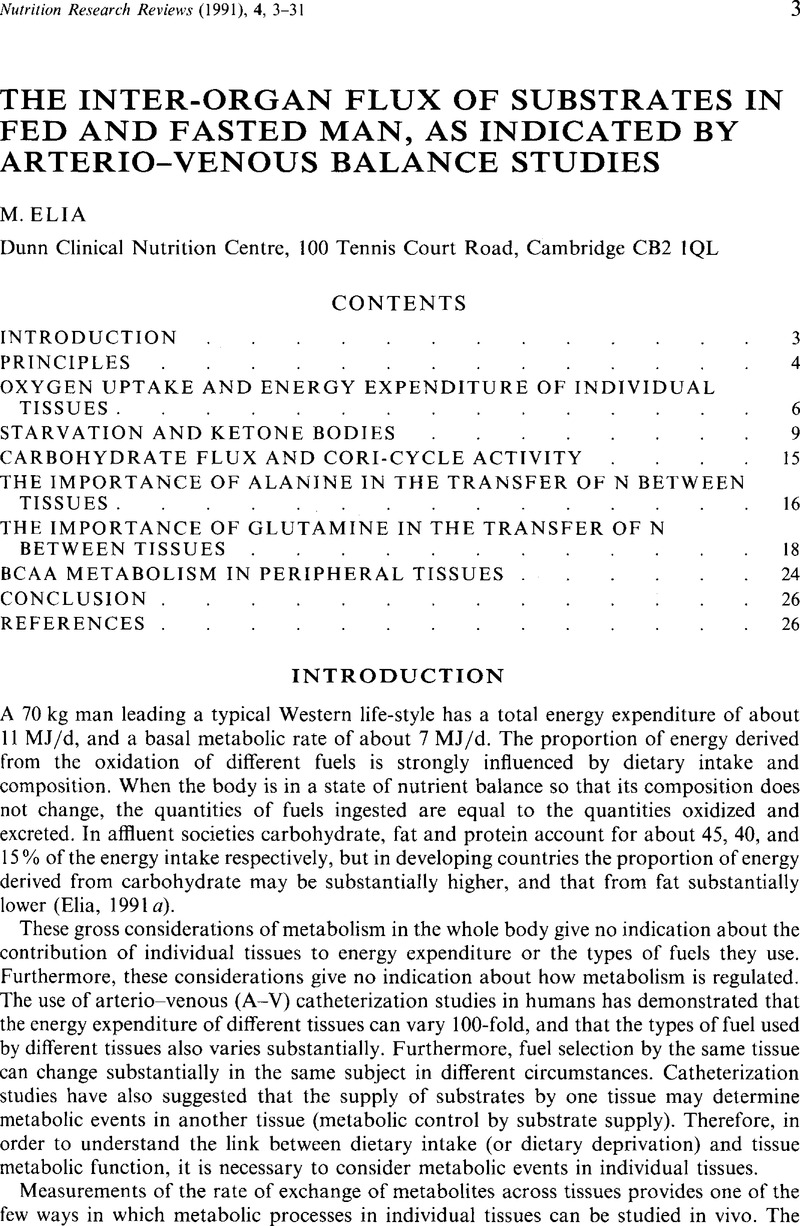Crossref Citations
This article has been cited by the following publications. This list is generated based on data provided by Crossref.
Khan, K.
Baker, B.A.
and
Elia, M.
1992.
Nutrient utilisation in muscle and in the whole body of patients receiving total parenteral nutrition.
Clinical Nutrition,
Vol. 11,
Issue. 6,
p.
345.
Elia, M.
1992.
Glutamine in parenteral nutrition.
International Journal of Food Sciences and Nutrition,
Vol. 43,
Issue. 1,
p.
47.
Elia, M.
1993.
Glutamine metabolism in human adipose tissue in vivo.
Clinical Nutrition,
Vol. 12,
Issue. 1,
p.
51.
Oftedal, Olav T.
1993.
The Adaptation of Milk Secretion to the Constraints of Fasting in Bears, Seals, and Baleen Whales.
Journal of Dairy Science,
Vol. 76,
Issue. 10,
p.
3234.
CARLI, F.
RONZONI, G.
WEBSTER, J.
KHAN, K.
and
ELIA, M.
1993.
The independent metabolic effects of halo thane and isoflurane anaesthesia.
Acta Anaesthesiologica Scandinavica,
Vol. 37,
Issue. 7,
p.
672.
Castillo, L.
Chapman, T. E.
Yu, Y. M.
Ajami, A.
Burke, J. F.
and
Young, V. R.
1993.
Dietary arginine uptake by the splanchnic region in adult humans.
American Journal of Physiology-Endocrinology and Metabolism,
Vol. 265,
Issue. 4,
p.
E532.
Kurpad, A. V.
Khan, K.
Calder, A. G.
and
Elia, M.
1994.
Muscle and whole body metabolism after norepinephrine.
American Journal of Physiology-Endocrinology and Metabolism,
Vol. 266,
Issue. 6,
p.
E877.
Simonsen, L.
Bulow, J.
and
Madsen, J.
1994.
Adipose tissue metabolism in humans determined by vein catheterization and microdialysis techniques.
American Journal of Physiology-Endocrinology and Metabolism,
Vol. 266,
Issue. 3,
p.
E357.
Selberg, Oliver
Radoch, Eva
Walter, Gerhard Franz
and
Müller, Manfred James
1994.
Skeletal Muscle Glycogen Content in Patients With Cirrhosis.
Hepatology,
Vol. 20,
Issue. 1,
p.
135.
Jebb, S.A.
Osborne, R.J.
Dixon, A.K.
Bleehen, N.M.
and
Elia, M.
1994.
Measurements of resting energy expenditure and body composition before and after treatment of small cell lung cancer.
Annals of Oncology,
Vol. 5,
Issue. 10,
p.
915.
Müller, Manfred J.
1995.
Hepatic fuel selection.
Proceedings of the Nutrition Society,
Vol. 54,
Issue. 1,
p.
139.
Nelson, Karl M.
1995.
Organ metabolism and nutrition: Ideas for future critical care.
Trends in Endocrinology & Metabolism,
Vol. 6,
Issue. 2,
p.
70.
Elia, M.
1995.
General integration and regulation of metabolism at the organ level.
Proceedings of the Nutrition Society,
Vol. 54,
Issue. 1,
p.
213.
Hulsewé, Karel W. E.
Deutz, Nicolaas E. P.
Blaauw, Ivo De
Van Der Hulst, Rene R. W. J.
Von Meyenfeldt, Maarten M. F.
and
Soeters, Peter B.
1997.
Liver protein and glutamine metabolism during cachexia.
Proceedings of the Nutrition Society,
Vol. 56,
Issue. 2,
p.
801.
Sparti, Andrea
DeLany, James P.
de la Bretonne, Jacques A.
Sander, Gary E.
and
Bray, George A.
1997.
Relationship between resting metabolic rate and the composition of the fat-free mass.
Metabolism,
Vol. 46,
Issue. 10,
p.
1225.
Hartman, W. J.
and
Prior, R. L.
1997.
Feeding and arginine deficient diets differentially alter free amino acid concentrations of hindlimb muscle in young rats.
Amino Acids,
Vol. 13,
Issue. 3-4,
p.
219.
Hartman, W. J.
and
Prior, R. L.
1997.
Portal-drained viscera and hepatic fluxes of branched-chain amino acids do not account for differences in circulating branched-chain amino acids in rats fed arginine-deficient diets.
Amino Acids,
Vol. 12,
Issue. 2,
p.
119.
Elia, Marinos
and
Lunn, Peter G.
1997.
The use of glutamine in the treatment of gastrointestinal disorders in man.
Nutrition,
Vol. 13,
Issue. 7-8,
p.
743.
James, L. A.
Lunn, P. G.
and
Elia, M.
1998.
Glutamine metabolism in the gastrointestinal tract of the rat assessed by the relative activities of glutaminase (EC 3.5.1.2) and glutamine synthetase (EC 6.3.1.2).
British Journal of Nutrition,
Vol. 79,
Issue. 4,
p.
365.
Binzoni, T.
Quaresima, V.
Barattelli, G.
Hiltbrand, E.
Gürke, L.
Terrier, F.
Cerretelli, P.
and
Ferrari, M.
1998.
Energy metabolism and interstitial fluid displacement in human gastrocnemius during short ischemic cycles.
Journal of Applied Physiology,
Vol. 85,
Issue. 4,
p.
1244.



